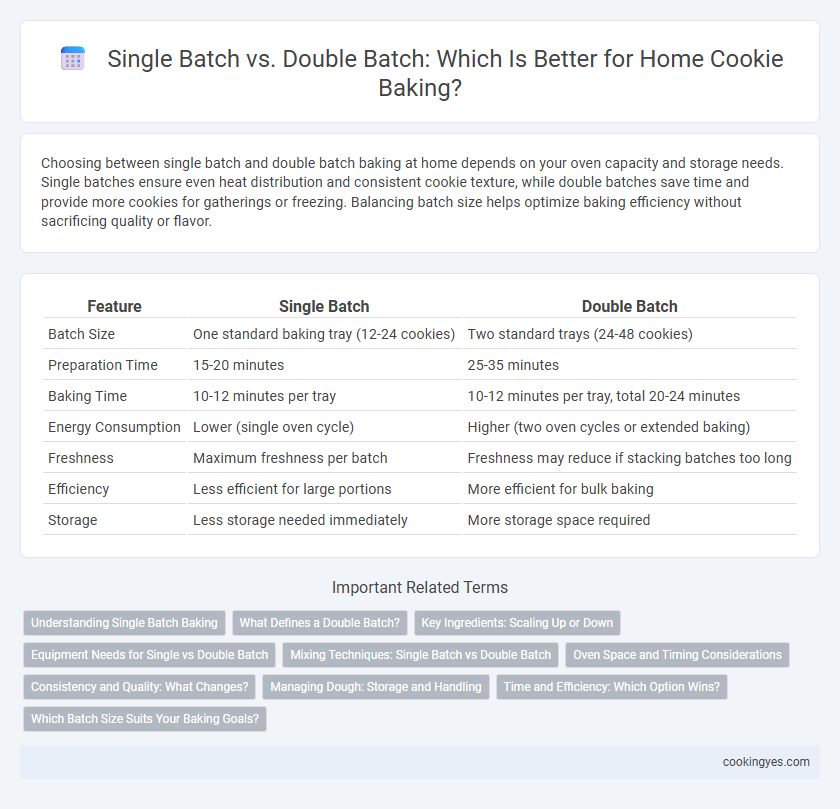Choosing between single batch and double batch baking at home depends on your oven capacity and storage needs. Single batches ensure even heat distribution and consistent cookie texture, while double batches save time and provide more cookies for gatherings or freezing. Balancing batch size helps optimize baking efficiency without sacrificing quality or flavor.
Table of Comparison
| Feature | Single Batch | Double Batch |
|---|---|---|
| Batch Size | One standard baking tray (12-24 cookies) | Two standard trays (24-48 cookies) |
| Preparation Time | 15-20 minutes | 25-35 minutes |
| Baking Time | 10-12 minutes per tray | 10-12 minutes per tray, total 20-24 minutes |
| Energy Consumption | Lower (single oven cycle) | Higher (two oven cycles or extended baking) |
| Freshness | Maximum freshness per batch | Freshness may reduce if stacking batches too long |
| Efficiency | Less efficient for large portions | More efficient for bulk baking |
| Storage | Less storage needed immediately | More storage space required |
Understanding Single Batch Baking
Single batch baking allows home bakers to control ingredient consistency and achieve uniform baking results by preparing one set of cookies at a time. This method minimizes errors related to ingredient measurement and oven temperature variations, ensuring better texture and flavor. Focusing on single batch baking enhances precision and reduces waste, making it ideal for perfecting recipes.
What Defines a Double Batch?
A double batch in home baking typically consists of twice the quantity of ingredients used in a single batch, resulting in approximately twice the number of cookies. This method requires proportional adjustments in mixing, baking time, and sometimes oven temperature to ensure even cooking and consistent texture. Careful portioning and even spacing on baking sheets help maintain uniform heat distribution for optimal results.
Key Ingredients: Scaling Up or Down
Scaling key ingredients accurately when moving from a single batch to a double batch in home cookie baking ensures consistent texture and flavor. Precise measurement of leavening agents like baking soda or powder is critical to prevent cookies from becoming overly dense or spreading too thin. Maintaining the right balance of sugar and fats supports proper caramelization and moisture retention in larger quantities.
Equipment Needs for Single vs Double Batch
Single batch cookie baking typically requires a single mixing bowl, one baking sheet, and limited oven space, making it ideal for small kitchens or minimal equipment setups. Double batch baking demands additional bowls, extra baking sheets, and ample oven capacity to handle multiple trays simultaneously, increasing equipment needs and preparation time. Investing in durable, stackable baking sheets and a high-capacity mixer streamlines double batch baking efficiency and consistency.
Mixing Techniques: Single Batch vs Double Batch
Single batch mixing ensures consistent ingredient distribution and precise control over dough texture, which is crucial for uniform cookie quality. Double batch mixing requires careful timing and thorough blending to prevent uneven ingredient incorporation and texture variation between batches. Optimal mixing technique in double batches involves dividing ingredients or using mechanical mixers to maintain homogeneity comparable to single batch results.
Oven Space and Timing Considerations
Single batch baking allows for optimal oven space utilization, ensuring even heat distribution and consistent cookie texture, while double batch baking maximizes output but may require rotating trays midway to prevent uneven baking. Timing considerations play a critical role; single batches typically bake faster and with predictable results, whereas double batches can extend total baking time and potentially compromise cookie quality if oven capacity is exceeded. Home bakers must balance oven size, heat retention, and timer adjustments to achieve the desired baking outcome when choosing between single and double batches.
Consistency and Quality: What Changes?
Single batch baking often results in more consistent cookie texture and flavor due to precise control over mixing and oven temperature, reducing variability. Double batching can introduce challenges such as uneven heat distribution and mixing inconsistencies, potentially affecting cookie quality. Home bakers aiming for uniformity in chewiness and taste typically prefer single batch processes to maintain optimal consistency.
Managing Dough: Storage and Handling
Single batch cookie dough is easier to manage, requiring minimal storage space and reducing the risk of overmixing or spoilage. Double batch dough demands careful portioning and airtight storage to maintain freshness, often benefiting from refrigeration or freezing to prevent bacterial growth and texture degradation. Proper handling techniques, such as labeling and using shallow containers, optimize dough longevity and ensure consistent baking results in home kitchens.
Time and Efficiency: Which Option Wins?
Single batch baking offers greater time efficiency for small quantities, reducing overall preparation and oven usage time. Double batch baking maximizes oven utilization by baking twice the amount in one go, saving energy and increasing output without doubling cleanup. For home bakers prioritizing speed and efficiency, double batching generally wins due to simultaneous ingredient mixing and consolidated baking cycles.
Which Batch Size Suits Your Baking Goals?
Choosing between single batch and double batch cookie recipes depends on your baking goals, kitchen space, and consumption needs. Single batches are ideal for small families or limited oven capacity, ensuring freshness and minimizing waste, while double batches save time and energy when baking for parties or meal prepping. Consider countertop space, storage availability, and how quickly cookies will be consumed to determine the most efficient batch size for your home baking.
Single Batch vs Double Batch for Home Baking Infographic

 cookingyes.com
cookingyes.com